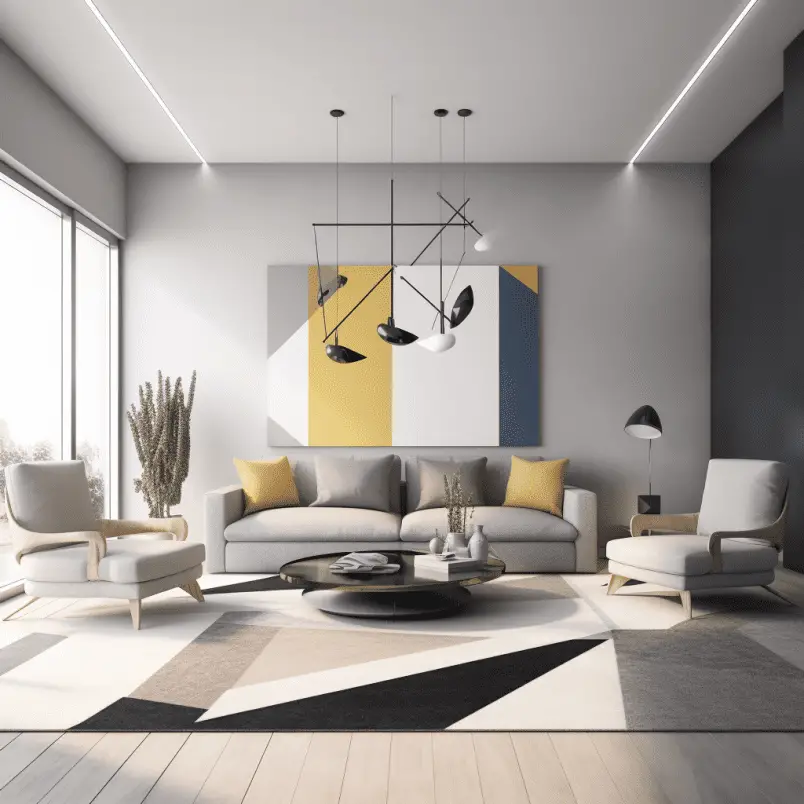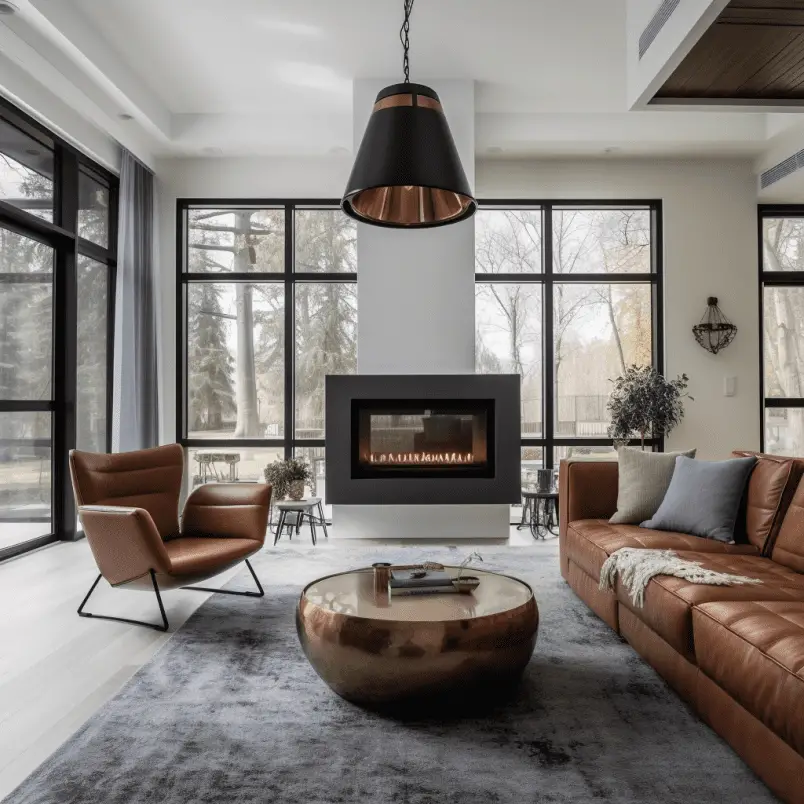In today’s world, interior design is not just about making a space look good; it’s about creating an environment that reflects your personality and lifestyle. Finding your interior design style can be challenging, especially if you’re not sure where to start. That’s why we’ve put together this guide to help you discover your personal style and get expert guidance on how to achieve the look you want. In just four easy steps, you’ll be on your way to creating a space that is both functional and beautiful. Whether you’re a homeowner or renter, an interior design enthusiast or just starting out, this guide will provide you with the knowledge and tools needed to transform your space into something truly special.
Quick tip before you start reading:
Save some time and speed up your finding process by taking our free interior design quiz. Get results instantly without subscribing or sharing any personal information.

Step 1: Explore Design Styles
When it comes to finding your interior design style, the first step is to explore different design styles through online research and inspiration boards. Online research is an excellent way to discover new styles and get inspired by other people’s designs. There are many websites and platforms available that can help you with your research, such as Pinterest, Houzz, and Instagram. These platforms offer a vast selection of images from professional designers and enthusiasts alike.
Creating an inspiration board is another great way to collect ideas for your interior design project. It allows you to gather all of your favorite images in one place, making it easier for you to visualize your ideal space. You can create a physical inspiration board by cutting out pictures from magazines or printing out images from online sources. Alternatively, you can create a digital inspiration board using tools like Canva or Adobe Spark.
When researching online and creating an inspiration board, remember that it’s essential to keep an open mind. Don’t limit yourself to just one style or color scheme; instead, try exploring different options until you find what speaks to you. Look for patterns in the images that catch your eye – do they have similar colors? Are they minimalist or maximalist? Identifying these patterns will help you narrow down the styles that appeal most to you.
Another tip is to check out our comprehensive list of all major interior design styles and select what fits best to you.
Step 2: Identify Personal Preferences
When it comes to interior design, personal preferences play a crucial role in determining the final outcome. Understanding your own style and what you like is essential for creating a space that feels comfortable and reflects your personality. In this step, we’ll explore how to identify your personal preferences by considering your lifestyle needs and determining your color and texture preferences.
Consider Your Lifestyle Needs
Before diving into the world of interior design, it’s important to consider your lifestyle needs. Your daily routine, hobbies, and family size can all influence the way you use your space. For example, if you have children or pets, you may need furniture that is durable and easy to clean. If you work from home, you may require a designated workspace with plenty of natural light.

To determine your lifestyle needs, start by making a list of activities that take place in each room of your home. Think about how each space is currently used and whether it meets your needs. Are there any areas that feel cluttered or underutilized? Are there any rooms that are rarely used? By identifying these pain points, you can begin to envision how each room could better serve its purpose.
Once you have a clear understanding of your lifestyle needs, think about how they can be incorporated into your design choices. For example, if you have young children who love to play on the floor, consider adding soft rugs or floor cushions for comfort. If you’re an avid reader who enjoys curling up with a book in the evening, create a cozy reading nook with a comfortable chair and good lighting.
Determine Your Color and Texture Preferences
Color and texture are two key elements of interior design that can greatly impact the overall look and feel of a space. When choosing colors for your home, consider both their aesthetic appeal and their psychological effects. Warm colors like reds and oranges can create a cozy atmosphere, while cool colors like blues and greens can promote relaxation.

Texture also plays an important role in interior design by adding depth and visual interest to a space. Consider incorporating different textures through fabrics like wool or linen, or through natural materials like wood or stone.
To determine your color and texture preferences, start by gathering inspiration from magazines or online sources. Create mood boards or Pinterest boards filled with images that speak to you. Look for patterns in the colors and textures that catch your eye – do you tend to gravitate towards neutral tones or bold hues? Do you prefer smooth surfaces or rough textures?
Once you’ve identified some key color and texture preferences, experiment with incorporating them into different areas of your home. Start small with accent pieces like throw pillows or curtains before committing to larger items like furniture or wall paint.
By taking the time to consider both your lifestyle needs and personal style preferences during the design process, you can create a space that truly feels like home.
Step 3: Consider Architecture and Existing Elements
When it comes to interior design, the architecture of your space plays a crucial role in determining what works and what doesn’t. Whether you’re dealing with a modern high-rise apartment or a cozy Victorian home, understanding the architectural style of your space can help you make informed design choices that will bring out its best features.
One of the first things to consider when evaluating the architecture of your space is its overall style. Is it sleek and modern, or does it have more traditional elements? Does it feature ornate details like crown molding and wainscoting, or is it more streamlined and minimalistic? Once you’ve identified the main architectural style of your space, you can start to explore different design options that complement and enhance its unique features.
Another important factor to consider when working with existing architecture is the layout of your space. Are there any unusual angles or corners that could be challenging to work with? Are there any areas that feel cramped or cluttered? By taking these factors into account, you can create a design plan that maximizes your available space while minimizing any potential problem areas.
In addition to considering the overall architectural style and layout of your space, it’s also important to work with any existing elements that are already in place. This might include things like built-in bookcases, fireplaces, or even structural features like exposed brick walls or ceiling beams. Rather than trying to hide these elements or work around them, try incorporating them into your overall design scheme for a cohesive look that celebrates their unique character.
When working with existing elements, it’s also important to think creatively about how they can be used in new ways. For example, if you have an old wooden ladder lying around, why not repurpose it as a rustic shelving unit for displaying books or plants? Or if you have an unused fireplace in your living room, consider filling it with candles or decorative logs for an eye-catching focal point.
Step 4: Mix and Match Styles
When it comes to interior design, there are no hard and fast rules. In fact, one of the most exciting things about designing your own space is the ability to mix and match different styles to create a unique look that reflects your personality and taste. Mixing styles can also help you achieve balance and harmony in your home decor. For example, if you have a modern sofa, try pairing it with an antique rug or vintage accent chair to add some warmth and character. Alternatively, if you have a traditional dining table, consider pairing it with contemporary chairs for a fresh, updated look.

There are many ways to experiment with mixing styles in your home decor. One approach is to start with a neutral base color scheme and then layer on different textures, patterns, and accents in contrasting styles. For instance, you could pair a sleek Scandinavian-style coffee table with an ornate Moroccan-inspired rug or mix mid-century modern furniture with bohemian textiles for an eclectic vibe.
Another way to mix and match styles is by incorporating unexpected elements into your design scheme. For example, you could hang a rustic wood shelf on the wall next to a sleek metal bookcase or place a vintage trunk at the foot of your bed as a decorative storage solution.
Ultimately, the key to successfully mixing styles is to trust your instincts and have fun with it! Don’t be afraid to try new things and take risks in your home decor choices. If you’re unsure where to start or need some guidance along the way, consider consulting with an interior design professional who can provide expert advice tailored to your personal style and preferences.
Consider Hiring an Interior Designer
While it’s possible to design your own space with the help of online resources and inspiration boards, hiring a professional interior designer can take your home decor to the next level. Interior designers have the expertise and experience to create a cohesive and polished look that reflects your personal style while also considering functionality and practicality.
When looking for an interior designer, consider their portfolio and style. Look for designers who have experience working on projects similar to yours or who specialize in the type of design you’re interested in. You should also consider their communication skills, as clear communication is essential for a successful collaboration.
Working with an interior designer can save you time, money, and stress in the long run by ensuring that every aspect of your design is carefully planned out before any work begins. They can also provide access to exclusive resources and products that may not be available to the general public.
Conclusion
In conclusion, finding your interior design style can be a fun and exciting process that allows you to express your personality and create a space that truly feels like home. By following the four easy steps outlined in this post, you can explore different design styles, identify your personal preferences and lifestyle needs, consider the architecture and existing elements of your space, experiment with mixing and matching styles, and consult with a professional interior designer for guidance and expertise.
Remember to have fun with your design choices and don’t be afraid to take risks – after all, it’s your space! With the right guidance and a little bit of creativity, you can transform any room into a beautiful and functional space that reflects your unique style. So go ahead – get inspired, start exploring, and let your imagination run wild!
FAQ
What is interior design?
Interior design is the art and science of enhancing the interior of a building to achieve a healthier and more aesthetically pleasing environment for the people using the space.
Why is it important to find my interior design style?
Finding your interior design style is important because it helps you create a space that reflects your personality, lifestyle, and tastes. It guides your choices in furniture, color schemes, materials, and layouts.
Where can I find inspiration for different design styles?
You can find inspiration for different design styles on various online platforms such as Pinterest, Houzz, and Instagram. These platforms offer a vast selection of images from professional designers and enthusiasts alike. You can also take our interior design quiz to speed up the process.
What is an inspiration board and how can it help me?
An inspiration board is a collection of images that represent the look and feel you want to achieve in your space. It can help you visualize your ideal space and guide your design decisions.
Can I use digital tools to create an inspiration board?
Yes, you can use digital tools like Canva or Adobe Spark to create a digital inspiration board. These tools allow you to gather and organize your favorite images in one place.
I’m just starting out in interior design. Can this guide help me?
Absolutely! This guide is designed to help anyone, whether you’re a homeowner, renter, interior design enthusiast, or just starting out, to discover their personal style and transform their space.
What are some popular interior design styles?
Some popular interior design styles include modern, contemporary, minimalist, industrial, mid-century modern, Scandinavian, traditional, transitional, and bohemian.
Can I mix different interior design styles?
Yes, you can mix different interior design styles to create a unique look that reflects your personal taste. This is often referred to as “eclectic” style.
How can I achieve the look I want in my space?
Once you’ve identified your interior design style, you can start making design decisions that align with that style. This includes choosing furniture, colors, materials, and layouts that reflect your style.
What if I’m still unsure about my interior design style after following these steps?
It’s okay to be unsure. Interior design is a personal and evolving process. You can always seek help from a professional interior designer or continue exploring different styles until you find what resonates with you.

